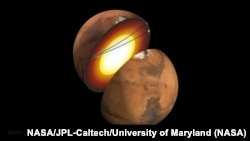Scientists now believe the largest quake ever recorded on Mars was the result of seismic activity, not a strike by a space object.
Instruments attached to the InSight lander identified the quake in 2021. The InSight lander is a Mars explorer operated by the American space agency NASA. On Earth, seismic activity causes earthquakes. Scientists often call seismic activity on Mars “marsquakes.”
NASA estimated the largest marsquake had a strength of 4.7. While this level of quake would not be considered major on Earth, it is very powerful on Mars.
Scientists say a marsquake happens when Martian soil is subjected to a buildup of pressure so great that it causes rock structures to break. So far, the InSight lander has identified, or detected, more than 1,300 marsquakes. The explorer uses a device called a seismometer to detect the ground movements.
The seismometer was designed to be extremely sensitive for the Martian environment. It aims to differentiate between seismic signals coming from inside Mars and activity coming from above the surface, such as wind or meteorite strikes.
Researchers look at other things to confirm whether a marsquake was caused by seismic activity below the surface or by an outside force hitting the planet. In the case of the strongest marsquake ever recorded, an international team of scientists looked for evidence of a crater that would have been created by a large meteorite hit.
The team was led by researchers from Britain’s University of Oxford. But scientists working for space agencies in Europe, China, India and the United Arab Emirates also took part. China has an explorer on Mars and the other agencies all have spacecraft orbiting the planet.
A recently released study describes the findings in Geophysical Research Letters.
The research team estimated that a 4.7-level marsquake would have created a crater at least 300 meters in diameter. Two other large marsquakes left craters of about 150 meters. So, the researchers searched satellite data collected by InSight as well as the other space agencies.
Each agency examined data from their satellites for evidence of a large crater, as well as other signs that a meteorite might have struck before the largest marsquake. Another sign, team members noted, could have been a dust cloud appearing in the hours after the quake.
But after several months of searching, the researchers said no new, larger crater was found. They said their examinations ruled out a meteorite strike as the cause of the 4.7 marsquake.
The researchers decided instead that the largest marsquake must have been caused by the release of powerful “tectonic forces” at work deeper inside the Red Planet. This finding suggests that Mars “is much more seismically active than previously thought,” the Oxford University team said in a statement.
Benjamin Fernando is a professor of physics at Oxford University who led the study. He said in a statement that scientists do not believe Mars has ongoing tectonic movements. Rather, Fernando said the team thinks the largest marsquake was “caused by the release of stress within Mars’ crust.”
He added that such stress is likely the result of billions of years of development on Mars, including the cooling and shrinking of different parts of the planet at different speeds. “We still do not fully understand why some parts of the planet seem to have higher stresses than others, but results like these help us to investigate further,” Fernando said.
Constantinos Charalambous is a planetary scientist at Imperial College London who helped lead the research. He spoke to Reuters news agency about the finding. He said it "represents a significant step forward in our understanding of Martian seismic activity – and takes us one step closer to better unraveling the planet's tectonic processes."
Fernando added, “One day, this information may help us to understand where it would be safe for humans to live on Mars and where you might want to avoid.”
I’m Bryan Lynn.
Bryan Lynn wrote this story for VOA Learning English, based on reports from Reuters, the University of Oxford and NASA.
______________________________________________
Words in This Story
seismic – adj. relating to or caused by an earthquake
meteorite – n. a piece of rock from outer space that has fallen to a planet’s surface
crater – n. a big hole left in the ground or an object by a force of impact
tectonic – adj. relating to the structure of the Earth and the way it is formed, changed and moved by forces inside it
stress –n. tension or strain
crust –n. the hard outer layer of certain things
unravel – v. to make something known or understood










Forum